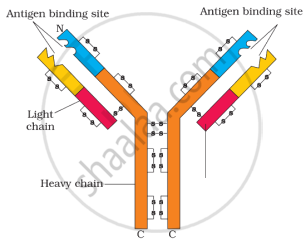Advertisements
Advertisements
प्रश्न
| When a microorganism invades a host, a definite sequence of events usually occurs leading to infection and disease, causing suffering to the host. This process is called pathogenesis. Once a microorganism overcomes the defence system of the host, development of the disease follows a certain sequence of events as shown in the graph. Study the graph given below for the sequence of events leading to the appearance of a disease and answer the questions that follow: |

(a) In which period, according to the graph there are maximum chances of a person transmitting a disease/infection and why? (1)
(b) Study the graph and write what is an incubation period. Name a sexually transmitted disease that can be easily transmitted during this period. Name the specific type of lymphocytes that are attacked by the pathogen of this disease. (2)
OR
(b) Draw a schematic labelled diagram of an antibody. (2)
(c) In which period, the number of immune cells forming antibodies will be the highest in a person suffering from pneumonia? Name the immune cells that produce antibodies. (1)
उत्तर
(a) Period of illness: The number of disease-causing microorganisms reaches its maximum during the period of illness so, there are maximum chances of a person transmitting a disease/infection at this stage.
(b) The incubation period refers to the period from the absence of symptoms to the beginning of minor symptoms. The incubation period is the length of time between the introduction of germs and the onset of the first illness symptoms. For instance, chickenpox takes 14-16 days to incubate. The sexually transmitted illness that can spread during this time is AIDS. The pathogen in this disease targets a specific type of cell called a macrophage.
OR
(b)

Structure of an antibody molecule
(c) In a person suffering from pneumonia, the number of immune cells forming antibodies will be at its highest during the period of illness. Antibodies are produced by B-lymphocytes.
APPEARS IN
संबंधित प्रश्न
Differentiate between
Active and passive immunity
Crypts of lieberkuhn are present in ______.
Transplantation of tissues/organs fails after due to non-acceptance by the patient's body which type of immune response is responsible for such rejections?
Which of the following acts as a physiological barrier to the entry of microorganisms into the human body?
Many microbial pathogens enter the gut of humans along with food. What are the preventive barriers to protect the body from such pathogens? What type of immunity do you observe in this case?
In the figure, structure of an antibody molecule is shown. Name the parts A, B and C. Show A, B and C in the diagram.

Why is an antibody molecule represented as H2L2?
Highlight the structural importance of an antibody molecule with a diagram. Name the four types of antibodies found to give a humoral immune response, mentioning the functions of two of them you have studied.
The type of immunity develops in the foetus after receiving antibodies through placenta is ______.
The following is well-known abbreviation, which have been used in this chapter. Expand to its full form:
CMI
